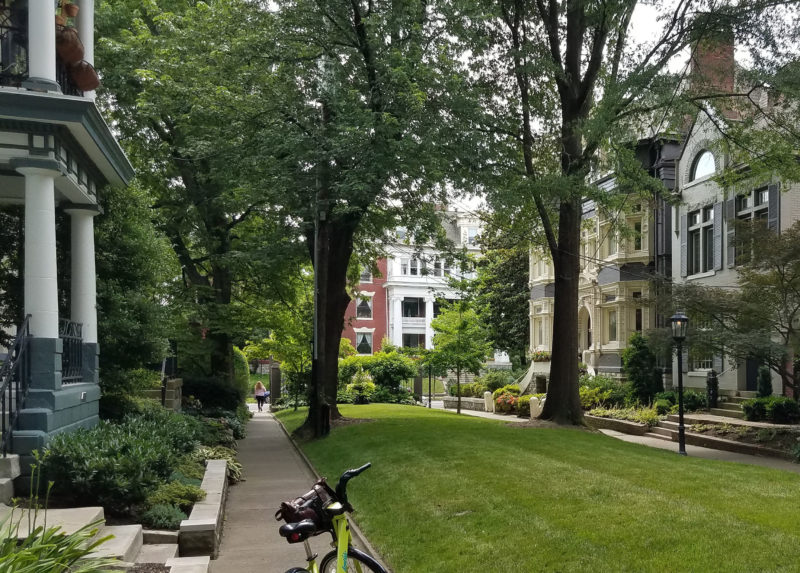KEY TAKEAWAYS
Live, Work, Play More and more people are being drawn to a walkable, less car-dependent lifestyle.
Revitalization Small towns and villages have the opportunity to provide the healthy, walkable lifestyle that makes urban living popular.
Increased Living Options Walkable, affordable places to live with good schools are difficult to find. Small towns and villages can provide options for young families who may not be able to afford urban living.
Towns and villages can offer a healthy and balanced lifestyle option by employing the same live, work, play qualities that make urban living popular to their own revitalization.
Modern suburbia – drive home from work, drive to soccer practice, drive to the grocery store, drive back home from soccer practice, do it all again tomorrow. Not only is this the life of many working parents, it also highlights the car-dependent lifestyle of suburban sprawl.
The past year has focused attention on where we live, work, and play and how those aspects of our lives intertwine. Whether or not to live in a dense city has been a major topic of discussion.
Though it is unlikely that we are seeing the end of cities, what we may be seeing is a reaction to the way cities have been revitalized. Exacerbated by the pandemic and new remote working opportunities, people are looking for places that offer more space, affordability, and amenities without sacrificing too much of what they like about city living.
For decades, major urban areas have experienced a revitalization because people are disenchanted with the car-dependent lifestyle of suburbia, the financial strain and lack of health and wellness that accompanies it. City streets have again become places of economic opportunity as more people move downtown, choosing a walkable, car-optional place to live.
While urban living continues to grow in popularity, development has become expensive. Remote working has people looking for places that offer more space, affordability, and amenities while still being walkable. Rather than an end to city living, we are seeing a reaction between the lifestyle offered by revitalized cities and the needs of residents looking for choices.
A return to small towns and villages won’t be the decline of cities, nor does it mean a rush back to suburbia. It is an opportunity to take the same success found in revitalizing cities and put it to use in the region. Rather than diminish urban living, towns and villages can work together with cities for regional options of places to live, work, grow, and be happy.
Embracing our villages and towns gives us the opportunity to provide true options of places and ways to live, as opposed to the limited choice of urban or sprawl. Small towns and villages have great potential – they’re a viable option for those looking for community and lifestyle traits found in urban areas. They are smaller, typically compact, and consist of walkable neighborhoods. They offer a variety of home choices, a main street, parks, entertainment, schools, and other daily needs within walking or biking distance.
Small towns and villages are well-positioned to attract new residents and homebuyers by offering the same walkable/mixed-use lifestyle that urban living offers, while also providing a spacious/affordable/walkable balance attractive to the younger generation looking to start a family.

How Small Towns and Villages Can Rise to the Occasion
Improve Walkability Walkable communities are physically and mentally healthier places to live. Towns and villages can offer healthier walkable environments residents may be looking for by making investments such as:
Zone for it by encouraging a vertical mix of uses, use build-to lines, face buildings to the street, place parking behind buildings, require shop fronts with lots of transparent glass, use the Gehl door ratio, and consider Form-Based Codes.
Make great streets part of a connected street network that has sidewalks, trees between the pedestrian and traffic, slower vehicular speeds, protected bike lanes, on-street parking, and embrace alleys or lanes.
Design dynamic public spaces that people want to walk to and places they want to patronize such as dining, entertainment, libraries, schools, parks, markets, etc. (Think Quincy Market in Boston, Campo dei Fiori in Rome, Las Ramblas in Barcelona, or the Embarcadero in San Francisco.)
Keep it green with street trees and a variety of types of parks such as pocket parks, playgrounds, and ball fields interspersed throughout each neighborhood.
Establish a Walkable School District Master Plan
A 2018 review of home buyers by Realtor.com has shown that nearly a quarter of people purchasing homes said that a good school district was an important factor in deciding where to buy a home. Of those, nearly three quarters were willing to give up on certain features – garages, large back yards, updated kitchens or updated bathrooms to get a better school. This shows how influential a school district is and how important it is to invest wisely in them. How we plan our school districts and design our schools has an opportunity to create flexible towns and address the systemic inequality that has been enacted for decades.
Currently, the number of walkable and affordable areas with good schools is small or difficult to find. This is where our towns and villages can both provide an option for places to live and blossom through their own revitalization. We must find ways to get resources to our towns and villages to enable them to rapidly address this growing need for options.
Conclusion
The pendulum is swinging in a different direction than we have seen over the past two decades, but that does not mean the decline of cities, nor does it mean a rush back to suburbia – a one-or-the-other fallacy. We should be thinking about revitalization differently. This is not a loss for cities, but an opportunity to take the same success that we have found in revitalizing our cities and put it to use in the region. An opportunity to truly provide options for people to live.

